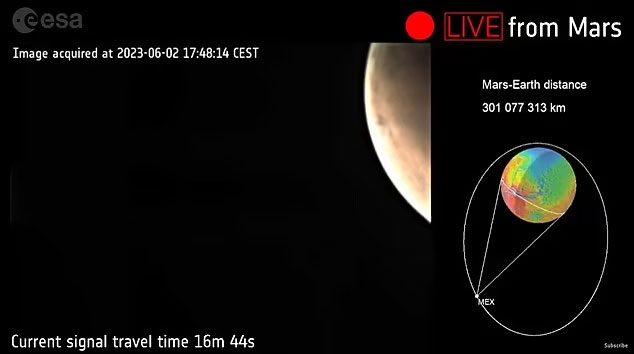The livestream event featuring the Mars Express spacecraft from the European Space Agency (ESA) on June 2 provided some of the closest images of Mars ever captured.

The livestream, which began at 11 PM on June 2 (Hanoi time) and lasted for one hour, showcased new images captured every few seconds. The signal transmission time from Mars to Earth, considering the current positions of both planets, is approximately 16 minutes and 44 seconds. After that, the images are relayed through cables and servers on the ground.
The first image was delivered around 11:06 PM, showing a small section of Mars that the Mars Express captured at 10:48 PM. With each subsequent image, Mars gradually moved across the screen from the upper right corner to the lower left corner, in accordance with the movement of Mars Express— the spacecraft orbiting Mars. In the final image of the livestream, taken at 11:42 PM, Mars nearly disappeared from the spacecraft’s view.
This livestream event commemorated the 20th anniversary of the launch of the Mars Express spacecraft by ESA. The Soyuz-FG/Fregat rocket lifted the spacecraft along with the Beagle 2 lander from the Baikonur Cosmodrome in Kazakhstan on June 2, 2003. The mission aims to capture 3D images of Mars’ surface, enabling experts to study the planet in greater detail.
The images captured by Mars Express were showcased in the first-ever livestream from Mars. (Video: ESA)
Mars Express and Beagle 2 entered Mars’ orbit on Christmas Day in 2003. On that day, Beagle 2 also attempted to land on Mars but failed to send signals back, likely due to its solar panels not deploying correctly and blocking the communication antenna. Mars Express has continued its operation as planned, conducting detailed studies of the Red Planet with seven different scientific instruments.
The livestream displayed images captured by the Visual Monitoring Camera (VMC) of Mars Express. The VMC was initially designed to monitor the separation of Beagle 2. After completing this task, it was turned off. However, scientists reactivated the VMC in 2007 to capture images.
“We have developed new, more complex operating and image processing methods to achieve better results from the camera, turning it into the eighth scientific instrument of Mars Express,” stated Jorge Hernández Bernal, a member of the VMC team.
The Mars Express operations team spent the past few months preparing for the livestream, including developing the necessary tools to upload images from the VMC to the internet as quickly as possible.
“Normally, we view images from Mars and know they were taken days ago. Now, I’m excited to be able to observe Mars live, or as close to ‘live’ as possible,” shared James Godfrey, operations manager of the Mars Express at NASA’s mission control center in Darmstadt, Germany, prior to the livestream.


















































